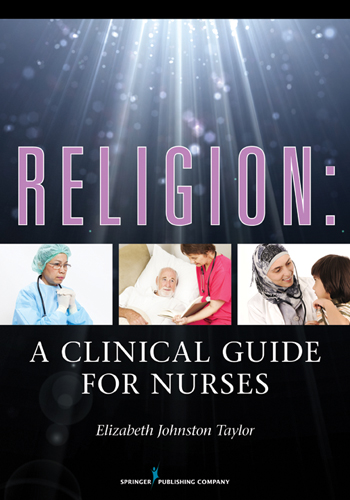 Religion: A Clinical Guide for Nurses
Religion: A Clinical Guide for Nurses
Beth Taylor is the champion of spiritual care in the real world of every day nursing practice. Her previous books, Spiritual Care: Nursing Theory, Research, and Practice (2002, Prentice Hall) and What Do I Say? Talking with Patients about Spirituality (2007, Templeton Press) offer great practical insight to the nurse at the bedside. Taylor hits the mark again with Religion: A Clinical Guide for Nurses. In the first half of the book, she discusses in detail how to assess and talk with patients about their religiosity, appropriately support religious rituals, and understand legal and ethical implications of religious care, including the nurse's rights and personal religiosity. In the second half of the book, various contributors offer beliefs, practices, and nursing implications for 22 world religions, religious clusters, and faith traditions.
Taylor begins by offering research that demonstrates religion is important to people (not just generic spirituality), noting that most often religion helps but sometimes can harm. Her explanation of a two-step approach to spiritual assessment is helpful. If there are religious beliefs and practices important to the patient, begin with a “screening assessment to determine superficially” (p. 30). Follow with a more focused assessment if religion is important to the patient, if they consent to further assessment, if you are competent to assess, and if religiosity is important to the patient's health. Competency is based on the nurse's knowledge/skill and the level of religious expression being assessed (public to private). Taylor notes, “Religious conversations with patients can reveal very deep spiritual and emotional pain…Can harm be done by leading a patient to express such pain when the nurse is incapable of addressing it?” (p. 22) Taylor agrees with nursing ethicist and theologian Marsha Fowler that nurses can cause harm if not equipped to deal with what is revealed. Taylor states, “If inquiring about patient religiosity is meeting the nurse's need or simply curiosity, then there is no therapeutic value in doing so. If, however, knowing the patient's religiosity is important for planning health care, then it is requisite to good care” (p. 66). Although Taylor writes that most nurses are competent to ask patients about public (what religion; attend church?) and semipublic (why they don't attend church) religiosity and that deeper spirituality/religiosity should be discussed with spiritual care experts, she provides insight for the nurse who ends up discussing more intimate spiritual or religious concerns, troubling feelings, and/or guilt.
Something fresh in this book is presentation of legal and ethical perspectives on religious care, including real-world case study examples. Taylor offers examples of statutory law and discusses legal rights of the religious nurse. She gives helpful ideas and ethical guidelines for religious care, stating about proselytizing, “Nurses must continue to remember what their role is and the inherent vulnerability of the patient. That is, evangelism that disconnects faith from health concerns and wounds a patient's freedom is not within the purview of the nurse” (p. 79). A chapter, “Integrating Personal Religiosity with Professional Practice” helps nurses come to grips with how our beliefs impact our care. Taylor doesn't argue that a nurse “must divide his or her religiosity from nursing practice; rather, …the nurse must try to identify personal beliefs and appreciate their potential impact on patient care and hold these in check as necessary to provide ethical care” (p. 87).
The 22 chapters on various religions range from Anabaptist-descended groups (Amish, Brethren, Hutterites, Mennonite) to Atheists, Baptists to Buddhists, Modern Pagans to Roman Catholics. A great strength of this information is that the chapters were written by practicing experts in each tradition, and reviewed by nurses practicing the tradition. So, for example, a Lutheran minister wrote and a Lutheran nurse reviewed the chapter on the Lutheran tradition.
Although this sounds like a heavy book, it is an easy read. The book isn't pie-in-the-sky; Taylor gives helpful tips, ideas, and guidelines for talking with patients about religion and spiritual needs. You'll find yourself resonating with the clinical examples. Although the book is not explicitly Christian, Taylor gives fair treatment to Christianity—a welcome contribution to spiritual care literature. She handles a tough subject professionally and realistically. I highly recommend this practical book for students, nurses, and educators.
--Reviewed by Kathy Schoonover Shoffner, PhD, RN
Adapted from a book review originally published in the Journal of Christian Nursing, July/Sept 2012